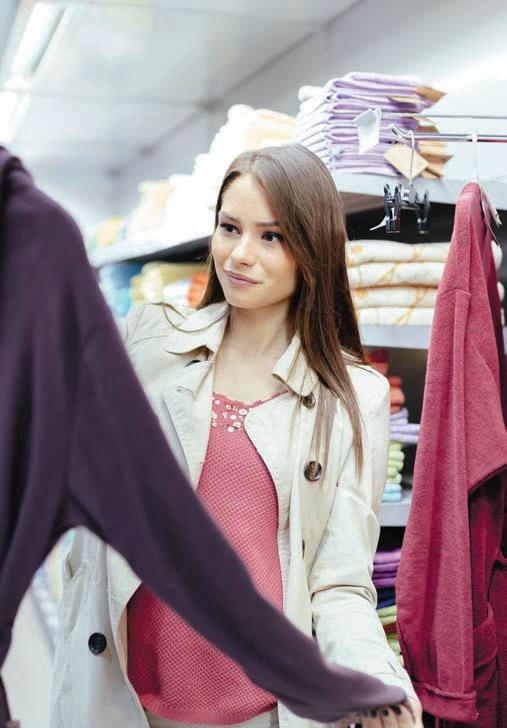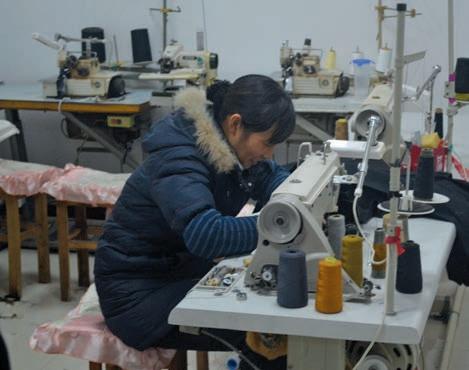
10 minute read
Our passion for McFashion
Our passion for
hy is ‘stuff’ so cheap? It’s become so normal that we’re probably used to it by now, but sometimes you need to say the words out loud, “These jeans are $10. This kids t-shirt is $3.50.” It seems unbelievable.
CHANGING ECONOMICS
The times have definitely a-changed. A woman I know (a child of the 70s) remembers shopping with her mother as a teenager. “We’d often go and ohhh and ahhh over all the expensive clothing.” If I expressed interest in something, my mother would inspect it (as a keen sewer) and declare “I could make that for half the price!.” Now, when we shop, she’ll pick something up and declare “You couldn’t make it for that.” Quality notwithstanding of course. If it seems that clothing is cheaper than ever, that’s because it is. The NSW Parliamentary
Research Service investigated relative price movements by CPI expenditure group between 2004-2014. Reporting on their findings in the November 2014 report “Rising cost of living: myth or reality?”, they found that the cost of clothing and footwear has decreased while all other groups increased. But what does this mean? As clothing becomes cheaper, the apparel business becomes all about the numbers. It’s a volume game. Low quality and high volume. It’s known as ‘fast fashion.’ Or landfill fashion, with the cheap prices and low quality of some items earning the nickname of ‘McFashion’. And it seems many of us have a passion for McFashion. It can be oh so tempting.
THE ‘EVOLUTION’ OF THE FASHION INDUSTRY
Shannon Whitehead, founder of Factory45, an accelerator program that takes sustainable apparel companies from idea to launch, talks about the modern fashion industry in her August 2014 article “5 Truths the Fast Fashion Industry Doesn’t Want You to Know”. According to Whitehead, there was a time when there were two fashion seasons – spring/ summer and fall/winter. Since 2014, the fashion industry operates in “micro-seasons”. And there are 52 of them each year. So consumers are no longer ‘out of fashion’ as seasons change twice a year, they’re out of fashion each week. And the only way to stay on trend is by accessing the revolving door of fast fashion – buy more, every week. Exhausting. The world now consumes a staggering 80 billion pieces of clothing each year. This is up 400% from two decades ago. McFashion is cheap and low quality. So not only is the garment ‘off trend’ from one week to the next, it’s unlikely to last from one week to the next. The simple fact is that much fast fashion doesn't survive more than a few washings. And as a consumer, what’s the point in looking after something when you can just toss it and buy a new one. We don’t buy items with a view to last now. Our relationship with clothing has changed.
ENOUGH ALREADY!
Many of us, realising our wardrobes can no longer comfortably hold their contents, commit to de-cluttering. This can be a welcome process. And while some things are immediately thrown into the bin, there’s usually a lot that is donated to charity. This also gives the declutterer a feeling of do-gooder’s euphoria. But what do charities do with the donations? The National Association of Charitable Recycling Organisations (NACRO) offers some insight. Of the post consumer waste recovered by charities: l 60% consists of items of clothing that can be re-worn or reused, l 15% can be torn into industrial wiper cloths, and
l 25% is unusable and sent to landfill
However, the decline in clothing quality impacts these figures. The percentage of items that can be re-worn or reused is shrinking. And the landfill grows.
McFashion…
BY VICKKI ELLIOTT


YOU DON’T WANT TO KNOW HOW THE SAUSAGE GETS MADE
There is a saying that goes something like this, ‘you don’t want to know how the sausage gets made.’ This is a glib analogy for the innerworkings of the fast fashion industry, but fairly accurate nonetheless – fun to buy, fun to wear, but do you want to know how, exactly did it get there? While we don’t spend too much time thinking about it, we likely know that someone, somewhere, is getting a raw deal if we’re buying a t-shirt for $3.50. Keeping in mind that that $3.50 still lets the supply chain make a buck (or two) on the way through. You may have noticed the ‘made in Bangladesh’ tags on some (or many) of your clothes. Since 2008, production of clothes for the Australian market has increased by 1,500 percent. The demand for the low cost of production found in Bangladesh means that it may soon overtake China as the largest global garment producer. So why Bangladesh? Worldwide minimum wages in the garment industry are reported in Tara Donaldson’s article in Sourcing Journal Online’s “2014: Global Sourcing to be More Costly as Worldwide Minimum Wages Continue to Rise”. Here she reports the wage rate in Bangladesh is the lowest in the world. The Bangladeshi government agreed upon a new salary structure that took effect on Dec. 1 2013. This structure announced that the new minimum wage would be set at $68 (USD), a 77 percent increase from the previous rate of $39 (USD). A member of Bangladesh Centre for Worker Solidarity, Kalpona Akter, told SBS News that on average factory workers do a sixday week, working shifts of about 12 hours. So that $68 is an hourly equivalent of 24c. Even when adjusted for lower costs of living in these countries, these rates are not a living wage. In Bangladesh a fair living wage is thought to be US $104 per month. Compare this to the average pay of a seamstress in Australia which, according to Payscale.com (the world’s largest database of salary profiles), is $19.78 per hour. The economics for profit driven companies are stark.
DANGEROUS CONDITIONS
The world’s attention turned to Bangladesh when, in April 2013, the Rana Plaza garment factory collapsed in Dhaka, Bangladesh. This disaster resulted in the death of 1,132 garment workers and focused on the conditions endured by these workers who produce much of the west’s (and the world’s) fashion. No Australian company made clothes at Rana Plaza.
GARMENT WORKER MONTHLY WAGE COMPARISONS (IN $US):
Bangladesh $68
Cambodia $140
Vietnam $90 - $128
Indonesia $199
India unskilled $130 semi-skilled $144 skilled $158
Pakistan $95
Turkey $414
Rana Plaza acted as a flashpoint bringing ethical production to the forefront of the media and broader community discussion. Since that time (and facing mounting pressure), more than 200 apparel brands, retailers and importers have signed the Bangladesh Fire and Building Safety Accord. Although only 12 on this list are Australian. (Though some of these Australian signatories represent multiple brands.) The Accord is an independent, legally binding agreement in which over 1600 factories are inspected and safety training conducted. It also allows workers to refuse to work in dangerous buildings and compels brands to fund repairs. These conditions are apparent in factories that produce garments across a range of price points. Nearly all brands are affected – it doesn’t matter how expensive the price tag. Brands from Kmart to Ralph Lauren source garments from Bangladeshi factories (and other low cost production centres). Though it’s not a case of ‘don’t know, don’t care’. A 2013 survey by Oxfam Australia found almost 70 percent of Australians would pay more for clothes if they knew overseas workers were paid a decent wage and had safe conditions. A further 81 percent think Australian clothing companies have a responsibility to ensure overseas workers are paid enough to cover basic needs (such as food, clothing, housing).

SO, WHAT’S THE ANSWER?
There are a number of possible responses to stories like this. Some shrug and think there is nothing they can do to improve things. Others think “Oh God, not another tragedy…” And still others may be galvanized to action to influence decision-makers directly. The answer is not to stop buying clothes with the ‘Made in Bangladesh’ label. Such a step would immeasurably damage the lives of those working in the garment industry. They are mostly women, wanting a better life for themselves and their families. Stop buying completely? Completely unrealistic. Though it might be good to stop bingeing. There is something to be said, for the ‘pause, consider, think’ approach to buying. But how to make better buying decisions? You’d rather put your money into a company that’s thinking about more than its bottom line. One that considers its supply chain and workers. The good news is, there’s no need to commit to hours or days of research trolling through annual reports and news stories to find information to make the ‘best choice’. In the wake of the Rana Plaza collapse, the 2013 Australian Fashion Report was released. This report, produced by Baptist World Aid grades companies based on their policies, supply chain traceability, monitoring programs and worker rights. Companies are awarded a grade from A to F based on their performance. The 2015 Australian Fashion Report added a further category, assessing whether companies are paying a wage that meets their workers’ basic needs and found only 9 percent of fashion brands are paying their workers a living wage. This report is extensive in its view of the fashion industry investigating 59 apparel companies that supply 219 major global and domestic fashion brands in Australia. The organisation uses a combination of responses to surveys sent to companies and publicly available information. Some companies choose not to respond. In 2015, this figure was around 25 percent. While improvements have been measured since the first report in 2013, there remains work to be done. Some 91 percent of companies did not know where all their cotton comes from and 75 percent did not know the source of all their fabrics. Most companies do not carry out regular random inspections or have a system in place for workers to raise complaints. Only two companies proved they paid a full living wage. Gershon Nimbalker, Advocacy Manager at Baptist World Aid says that “it doesn’t take much for the end-consumer to make a difference to the lives of those making our clothes. Research shows an additional 30c per t-shirt would ensure living wages are met in Bangladesh.” Importantly, some Australian companies have made significant improvements. Since 2013, Kmart and Cotton On have improved their traceability of suppliers throughout their supply chains and Country Road and the Sussan Group have improved worker wages. Though one of the worst overall performers was the Just Group, owner of stores including Just Jeans, Portmans, Jacqui E and Peter Alexander, who received an overall D-grade, with an F-grade for worker rights. Also performing badly was Best & Less receiving a D-grade and Lowes receiving an F-grade. The 2015 Australian Fashion Report has an accompanying Ethical Fashion Guide that can be downloaded or ordered in hardcopy from www.behindthebarcode. org.au. This guide has the full list of companies and brands with their grades. Another organization takes things a step further. Good On You is a social enterprise created by Ethical Consumers Australia and provides an app that “helps you choose brands that have a positive impact on people, the planet and animals – and to avoid brands that don’t deserve your money.” It provides ratings for more than 1,000 brands showing how each performs on labour rights, the environment and animal protection. Development of the app was funded by a successful crowdfunding campaign in July 2015. www.goodonyou.org.au So help is at hand. Use the tools available. Be more aware. Put more pressure on the brands you like and buy. Because, according to Daisy Gardener, Oxfam's corporate accountability and fair trade adviser, Australians are lobbying firms - and it counts. u


9428 1877








